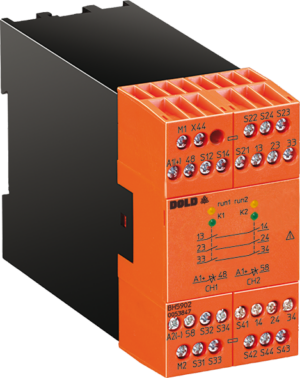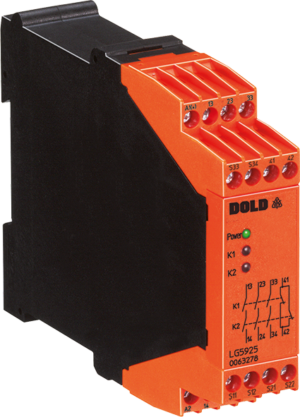Importance of Light Curtain Relays in Industrial Safety
Light curtain relays play a critical role in ensuring safe operation around dangerous equipment by facilitating rapid disconnection of the power supply to machinery when a person or object interrupts the infrared light beams projected by safety light curtains. These relays process signals from light curtain sensors and trigger immediate safety responses, helping to reduce the risk of accidents in high-risk applications such as robotic cells, automated assembly lines, and material handling zones.
Similar to a photocell relay that activates in response to changes in light intensity, light curtain relays are designed to trigger safety technology instantly upon beam interruption. This makes them ideal for preventing unintended access or contact with hazardous motion during production processes.
Their application in industrial environments supports stringent safety standards and compliance with multiple safety categories and performance levels. As part of a complete solution, light curtain relays contribute to reliable protection and seamless integration with other safety devices like emergency stops and safety controllers. Their proven response time, support for dual channel operation, and durability in harsh environments make them essential for achieving maximum safety.
Components of Light Curtain Systems
Safety Light Curtains
A safety light curtain is a non-contact protective device designed to detect the presence of objects or people in hazardous areas. Using a grid of synchronized infrared light beams, these systems provide precise object detection across the sensing field, instantly stopping machine motion when the beam field is interrupted. They are widely used in space-critical applications where physical guarding is impractical, and they offer varying levels of protection based on the required safety function and safety category.
Light Curtain Relays
Light curtain relays act as the core interface between the light curtain sensors and the machine’s control system. They ensure safe shutdowns and support features such as reverse polarity protection, screw connection terminals, and compatibility with diverse supply voltage ranges. These relays enable reliable operation and quick reaction times to maintain operator safety in complex industrial setups.
Safety Controllers
Safety controllers coordinate signals from multiple safety devices, including light curtain relays, emergency stop buttons, and interlock switches. These intelligent units monitor safety functions in real-time and ensure a comprehensive range of safety inputs are processed effectively. Configurable to match specific performance levels and safety categories, they are crucial for managing industrial applications with varying risk profiles.
Types of Light Curtains
Finger Protection
Light curtains designed for finger protection offer narrow beam spacing and short sensing ranges, ideal for tasks that require close interaction with machine components. These are typically used in applications like small press operations, pick-and-place robots, or assembly stations where precise object detection and minimal intrusion distance are critical.
Hand Protection
Hand protection light curtains are suited for wider sensing fields and slightly larger objects. Their sensing resolution accommodates hands or tools, making them suitable for operations involving loading or unloading tasks, where operators frequently reach into machine access zones.
Body Protection
Body protection systems provide coverage over large areas, allowing detection of full-body presence. With fewer beams spaced farther apart, they are ideal for perimeter guarding around large machinery or robotic cells, ensuring safe operation during maintenance or access. These light curtains are commonly deployed in environments demanding maximum safety and robust performance.
Innovations in Light Curtain Technology
PNP and NPN Polarity in Single Models
Modern light curtain relays often support both PNP and NPN output configurations within the same model, enhancing their adaptability across different control systems. This dual polarity design simplifies inventory management and expands the product range’s compatibility across global installations.
Built-in Muting Features
Built-in muting enables selective deactivation of light curtain sensors when material is expected to pass through, without compromising overall safety. Especially useful in automated conveyor systems, muting functions are critical in maintaining smooth production processes while ensuring the safety function remains intact for human intervention.
Cascade Connections
Cascadable light curtain systems allow multiple segments to be linked together, covering irregular machine shapes or extended access points. This innovation reduces wiring complexity, minimizes terminal block usage, and supports reliable protection for a wide range of application options.
Integration with Other Safety Features
Photoelectric Sensors
Light curtains often work in conjunction with photoelectric sensors to detect object position, presence, or movement beyond the primary safety zone. These auxiliary safety sensors contribute to performance levels and enhance precise object detection during machine operation.
Intelligent Mounting Systems
Modern safety light barriers include intelligent mounting brackets that simplify alignment, allow for quick installation, and ensure consistent sensing field accuracy. These systems support screw connection fixtures and LED indicators for visual status, which helps streamline maintenance and diagnostics.
Trusted Brands and Products
ReeR Solutions
ReeR is renowned for delivering safety light curtains and relays with advanced technology and wide-range options. Their products support multiple safety categories and offer features like built-in muting, dual channel operation, and compatibility with safety controllers, making them a leading choice for industrial safety applications.
Pilz Offerings
Pilz offers a comprehensive range of safety relays and light curtain sensors that meet the highest safety level requirements. With models suited for finger, hand, and body protection, Pilz solutions are designed to operate reliably in harsh environments and deliver consistent performance across complex machine safety architectures.
Installation and Configuration
Easy Installation Procedures
Light curtain relays and sensors are designed for fast deployment using standardized mounting hardware and screw connection terminals. Pre-wired terminal blocks and LED indicators simplify diagnostics during setup, helping reduce downtime and installation time.
Configurable Safety Controllers
Safety controllers can be easily programmed to accommodate various light curtain sensor configurations and performance levels. Their modular design and intuitive software interface allow technicians to create tailored safety solutions that integrate with existing control systems.
Benefits of Light Curtain Relays
Rapid Response and Emergency Stops
The immediate response time of light curtain relays ensures machines stop the moment the beam field is disrupted, minimizing the chance of injury. Their use in emergency stop circuits supports compliance with stringent safety standards and enhances the overall protective function.
Minimization of Wiring Requirements
Cascade systems and integrated safety controllers reduce the complexity of wiring and terminal block management. This streamlined approach leads to easier maintenance, lower costs, and reduced installation errors in safety circuits.
Streamlining Operations
Light curtain relays support reliable operation and safe interaction between humans and machines. By enhancing the safety function without slowing down production, they offer a balanced solution that improves efficiency while safeguarding operators in high-risk areas.
Meeting Safety Standards
Compliance with Industrial Regulations
All components, from safety relays to safety light barriers, are engineered to meet international standards for industrial environments. These include certifications related to safety category, performance level, and functional safety. Compliance ensures the entire system upholds consistent protection, even in demanding conditions or complex machine arrangements.


